 Paul Smith's Hotel, between 1901 and 1905 (Library of Congress)
Paul Smith's Hotel, between 1901 and 1905 (Library of Congress) 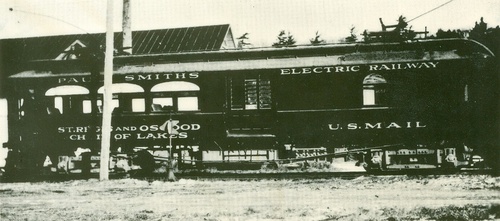 Paul Smith's electric rail car. Undated.
Paul Smith's electric rail car. Undated.
From Edna Finn's files, courtesy of Mary Hotaling. 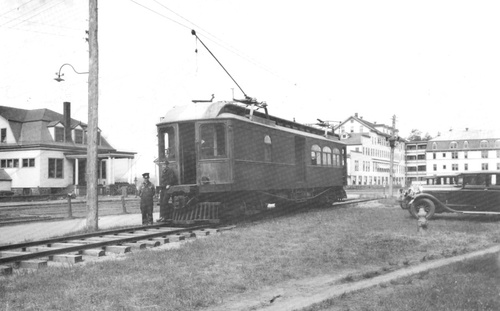 Paul Smith's electric rail car at Paul Smith's Hotel, undated. From Edna Finn's files, courtesy of Mary Hotaling.
Paul Smith's electric rail car at Paul Smith's Hotel, undated. From Edna Finn's files, courtesy of Mary Hotaling. 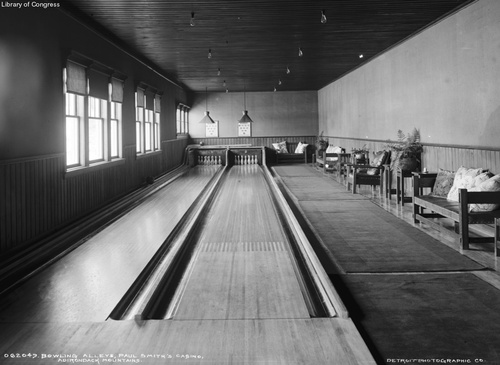 Bowling alleys, Paul Smith's casino, between 1900 and 1905
Bowling alleys, Paul Smith's casino, between 1900 and 1905  Private dining room, Paul Smith's casino, between 1900 and 1905
Private dining room, Paul Smith's casino, between 1900 and 1905 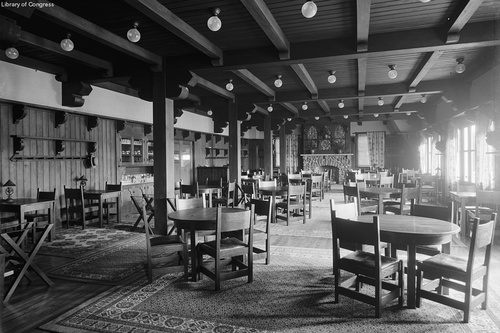 The Grill room, Paul Smith's casino, between 1900 and 1905
The Grill room, Paul Smith's casino, between 1900 and 1905 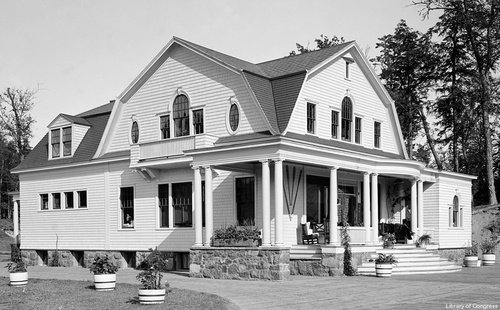 Paul Smith's General Store, between 1900 and 1906
Paul Smith's General Store, between 1900 and 1906  Paul Smith's Hotel, between 1901 and 1910
Paul Smith's Hotel, between 1901 and 1910 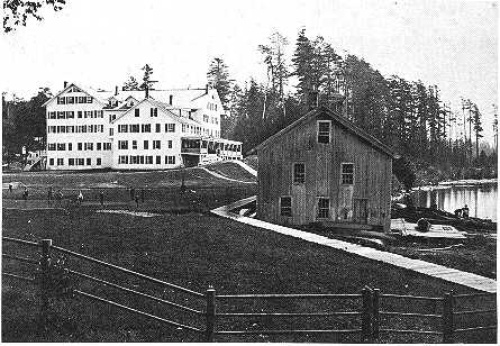 Paul Smith's Hotel, circa 1892 (Wikipedia)
Paul Smith's Hotel, circa 1892 (Wikipedia) 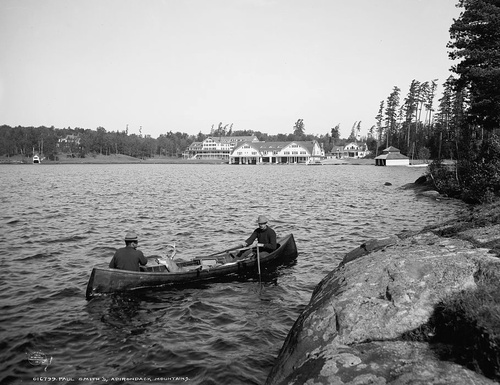 Guide boat, Lower Saint Regis Lake, Paul Smith's in background, 1903 (Library of Congress)
Guide boat, Lower Saint Regis Lake, Paul Smith's in background, 1903 (Library of Congress) 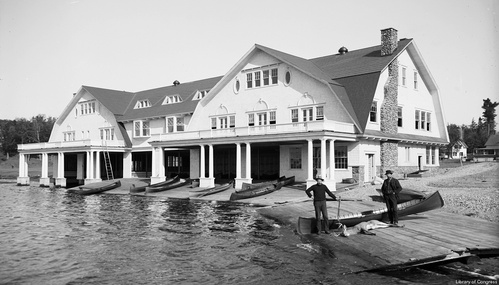 Paul Smith's Hotel boat house, between 1901 and 1905
Paul Smith's Hotel boat house, between 1901 and 1905 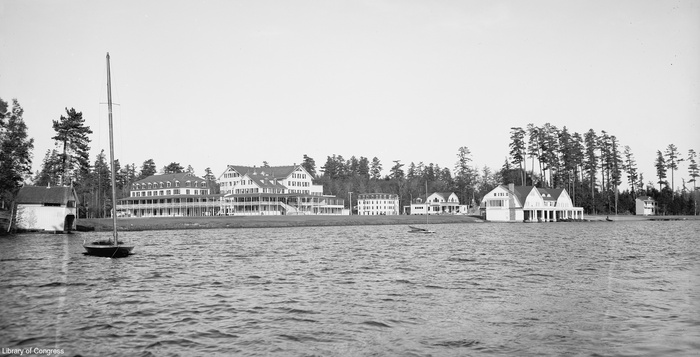 Paul Smith's Hotel, c. 1903. Looks like an Idem sailboat at left.
Paul Smith's Hotel, c. 1903. Looks like an Idem sailboat at left.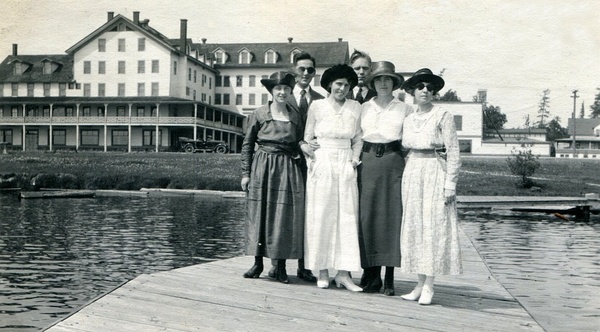 Verdo Newman, center, and friends at Paul Smiths Hotel, 1919. Courtesy of Lynn Newman Paul Smith's Hotel, formally known as the Saint Regis House, was founded in 1859 by Apollos (Paul) Smith on Lower St. Regis Lake in the town of Brighton in what would become the village of Paul Smiths; it was one of the first wilderness resorts in Adirondacks. In its day it was the most fashionable of the many great Adirondack hotels, patronized by American presidents Grover Cleveland, Theodore Roosevelt and Calvin Coolidge, celebrities like P.T. Barnum, and the power elite of the latter half of the 19th century, such as E. H. Harriman and Whitelaw Reid. Smith died in 1912, but the hotel continued under his son, Phelps, until it burned down in 1930. It was subsequently operated as an exclusive club house and cabins.
Verdo Newman, center, and friends at Paul Smiths Hotel, 1919. Courtesy of Lynn Newman Paul Smith's Hotel, formally known as the Saint Regis House, was founded in 1859 by Apollos (Paul) Smith on Lower St. Regis Lake in the town of Brighton in what would become the village of Paul Smiths; it was one of the first wilderness resorts in Adirondacks. In its day it was the most fashionable of the many great Adirondack hotels, patronized by American presidents Grover Cleveland, Theodore Roosevelt and Calvin Coolidge, celebrities like P.T. Barnum, and the power elite of the latter half of the 19th century, such as E. H. Harriman and Whitelaw Reid. Smith died in 1912, but the hotel continued under his son, Phelps, until it burned down in 1930. It was subsequently operated as an exclusive club house and cabins.
For years the hotel was kept intentionally primitive, offering neither bellboys nor indoor bathrooms. It started as a seventeen room inn, though by the start of the 20th century it would grow to 255 rooms with a boathouse with quarters for sixty guides, stables, casino, bowling alley, and a wire to the New York Stock Exchange. It also had woodworking, blacksmith, and electrical shops, a sawmill and a store. Stagecoaches delivered guest to the hotel until 1912, when a short electric railroad connected it to the nearest main line.
Adirondack Daily Enterprise, August 22, 1987
'Pol' Smith made fortune in Adirondacks
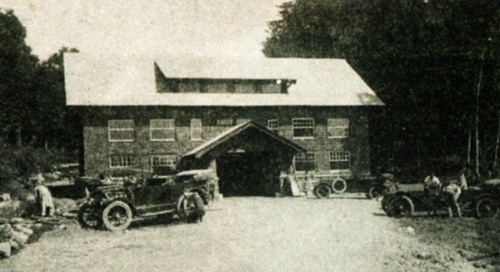 Paul Smith's hotel garage. Adirondack Daily Enterprise Weekender, February 1, 1991 By JOHN J. DUQUETTE
Paul Smith's hotel garage. Adirondack Daily Enterprise Weekender, February 1, 1991 By JOHN J. DUQUETTE
While working the freight barges on Lake Champlain a young man from Vermont would often glance across the lake to admire the stately range of mountains ruggedly silhouetted against the western sky. As the bluish mountains seemed to beckon to him, he mused that he would some day go there to seek his fortune. When he did get around to go, he found not only the fortune he sought but also a fame that was destined to exceed his most optimistic dreams. In fact some 56 years later his name would appear in. print more frequently than that of the President of the United States. Strangely, though, it was not his given name.
On the 20th day of August, back in 1825, a proud pair of parents in Milton, Vt. christened their new born son Apollos Austin Smith. As soon as the boy came of age he was off to the woods to pursue his favorite pastimes of hunting, trapping and fishing.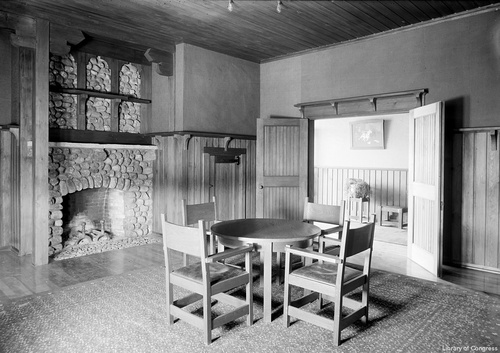 Smoking room, Paul Smith's casino, between 1900 and 1905
Smoking room, Paul Smith's casino, between 1900 and 1905 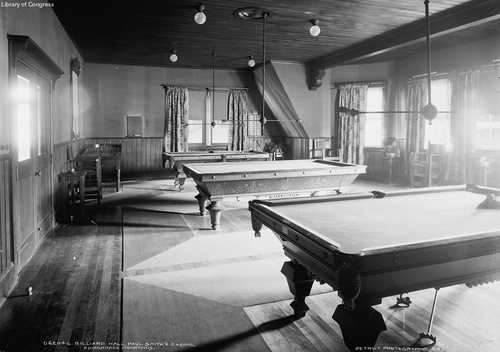 Billiard hall, Paul Smith's casino, between 1900 and 1905
Billiard hall, Paul Smith's casino, between 1900 and 1905
These early leanings later influenced the young man's decision to cross the lake and enter the field of guiding. Family friends, who were former Vermonters, had settled around Loon Lake where they were ideally positioned to introduce young Apollos to the incoming sportsmen. The area offered excellent hunting and fishing and our novice guide had little trouble in building up a clientele of satisfied customers. His background training in woodcraft lore was coupled with a masculine personality which assured his success not only with the patrons but also with the native fellow guides who, although they liked and admired the newcomer, could not cotton up to that mythological Greek moniker Apollos so they quickly shortened it to "Pol."
Phonetically his acquired nickname was mistaken for Paul, and he apparently had no objections to the application. In fact he perhaps didn't care too much for the name himself since he always signed his name A.A. Smith prior to the time he acquiesced to "Paul."
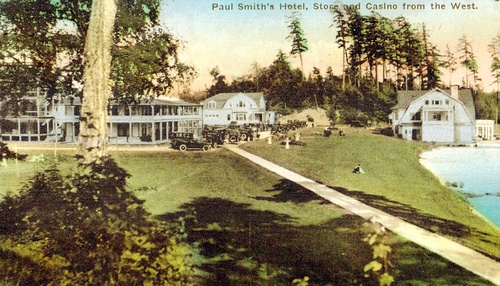 Postcard courtesy of Noreen OslanderPaul Smith was noted for his sense of humor. On one occasion a group of guided parties decided to join forces for a deer hunt. The hounds were put out to drive a deer to water while the armada of guideboats waited out on the lake. Soon a large buck leaped from the shore to begin its frantic swim. There was a mad rush of boats to intercept while many shots were being fired. With a mighty pull on the oars Paul capsized his boat. After the hunt, when all were gathered on shore, his comrades proceeded to ridicule Paul for falling out of his boat. "Fall out?" cried Paul, "I jumped in to save my life. With all that crazy shooting going on the only safe place was under water!"
Postcard courtesy of Noreen OslanderPaul Smith was noted for his sense of humor. On one occasion a group of guided parties decided to join forces for a deer hunt. The hounds were put out to drive a deer to water while the armada of guideboats waited out on the lake. Soon a large buck leaped from the shore to begin its frantic swim. There was a mad rush of boats to intercept while many shots were being fired. With a mighty pull on the oars Paul capsized his boat. After the hunt, when all were gathered on shore, his comrades proceeded to ridicule Paul for falling out of his boat. "Fall out?" cried Paul, "I jumped in to save my life. With all that crazy shooting going on the only safe place was under water!"
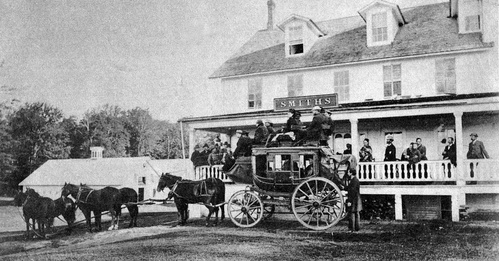 Stagecoach arriving at Smiths.
Stagecoach arriving at Smiths.
Adirondack Daily Enterprise, August 21 1993In order to add to his income Paul decided to build a small lodge to house his many followers. He purchased some land on the North Branch of the Saranac River adjacent to where the present bridge spans that stream on the road to Loon Lake. Here, in 1852, he built "Hunter's Home" which was soon filled to capacity. The cocktail lounge consisted of a barrel of whiskey standing in one corner of the main room with a tin dipper attached by a piece of string. By placing four cents on the barrelhead a guest could open the spigot and draw off a dipperful of rye. From this humble beginning came the start of the most fabulous career in the annals of Adirondack hostelry.
As Paul gained in knowledge of the surrounding territory he ventured farther afield to explore additional hunting and fishing grounds. On one such expedition he made camp on the north shore of what was then called Follensby Pond but which later became Lower St. Regis Lake. With him was a client named Daniel Sanders, a lawyer from Boston, who was much taken with the beauty of the place. Sanders suggested to his guide that he should build a larger hotel here where the sportsmen could bring their wives and children for summer vacations.
Upon his return to Hunter's Home Paul mentioned the idea to Dr. Loomis, one of his wealthy patrons. Loomis was all for the plan and offered to loan Paul enough money to get started. The guide quickly bought fifty acres of land and in 1858 began to build a hotel of 20 rooms which was opened for business the next year. From this point on he never stopped building. His popularity drew ever increasing patronage to his establishment and as the money poured in, he reinvested in more plant and more land. His shrewd land deals brought icing to the cake. With a down payment of $1,000 he purchased 13,000 acres of adjoining land, the total cost of which was to be $20,000. Shortly thereafter he sold a campsite on Upper St. Regis, of only 5 acres for $20,000 to a wealthy Baltimore family leaving the remaining parcel free and clear of debt. This was the beginning of a trend whereby the rich and famous suddenly wanted to own a piece of Adirondack shoreline on which they could build their ornate camps. With all of Lower St. Regis, Spitfire, and Upper St. Regis Lakes in his pocket Paul was in the catbird seat. Camps soon dotted the shores with such owner's names as Garrett, Stokes, Polhemus, Reid, Hutton, Earle, Huntington, Trowbridge, Drake, Hoe, Cooper, Runyon, McAlpin, Slade, Chase, and Bianchi; a who's who in America!
All of these owners were, of course, graduates of Paul Smith's Hotel which by the early 1900s had grown to 250 rooms and "Millionaire's Row" offered more privacy. The hotel complex by now boasted a guide house, casino, store, sawmill, men's dorm, girl's dorm, and its own Post Office. (Guess who was postmaster). In 1906 an electric railway was built to carry passengers and private cars from Lake Clear Junction to the hotel grounds. This innovation allowed the wealthy owners of stylish private railroad cars to embark from New York City and arrive at Paul Smith's without having to leave the confines of their ornate parlor cars. Quite a departure from Hunter's Home!
Such affluence did not affect Paul in the least. He rubbed shoulders with millionaires in the same relaxed manner that he displayed while bantering with his guides or the hired help. He maintained a keen sense of humor and was an outstanding story teller to the extent that it was said that his latest joke could buy a drink in any of the northern taverns from Saranac Lake to Malone. Here's an example: Paul was seated on the veranda one morning when a very verbose female guest invaded his reverie with an inane outburst while pointing to some virgin pines along the fringe of the grounds, "My goodness," she cried, "I don't remember seeing those trees last season." The white pines to which she pointed reached up to over 150 feet in height. "No," said Paul, "we have wonderful soil up here. We just set those out this spring."
Before his contemporaries, Paul fully realized the possibilities of electric energy and acted on his insight. He developed hydro generating stations at Keese's Mills, Franklin Falls, and Union Falls with transmission lines reaching into three counties. His own sons doubted his sanity when he instigated these grandiose schemes but papa emerged smelling like a rose. His eldest son, Phelps, died in 1937 leaving an estate of over $2 million in cash, the hotel company, an electric company, a telephone company, and some 50,000 acres of land. All of these assets were willed to establish a Paul Smith's College in memory of his father. The irony of this bit of philanthropy is reflected in Paul's favorite remark "There's no fool like an educated fool."
The former Vermont boy — barge worker, guide and innkeeper has left his indelible mark on the pages of Adirondack history. Through his portals came Presidents, Governors, Mayors, captains of industry, moguls, and a sick doctor named Edward L. Trudeau. More than any one person he brought an impact of prosperity to the vicinity of Saranac Lake.
Today Paul Smith's College is alive and well.
In addition to all of the publicity he received in books, magazines, newspapers, and advertising brochures, his name also was on the mail bearing the Paul Smiths post mark, as well as the address on incoming mail. Add to this list the tickets and time tables associated not only with the Paul Smiths railway but also those same items from the major connecting lines which included the name of their destinations. Finally there were the thousands of letter heads and bills from both. The electric and telephone companies that went out monthly over the years.
Some 50 years ago, when I first joined the electric company, the payment of a customer's monthly bill arrived in the mail with an added notation that I can still recall. Under the billhead banner which read PAUL SMITH'S ELECTRIC LIGHT & POWER COMPANY some wag had scrawled "What no steamship lines?"
Paul died on Dec. 15th 1912 and 18 years later, on Sept. 5th, 1930, the massive hotel structure burned to the ground. This tragic event also heralded the demise of the era of the grand old Adirondack hotels.
Thankfully Paul did not survive to witness the decline and fall of his empire.
Franklin Gazette, June 20, 1879
UP SOUTH
[…]
A very serious and nearly fatal accident occurred to Mr. A. A. Smith, proprietor of the St. Regis Lake House, on the afternoon of Wednesday last. He was standing upon a staging, and had just taken a plank that had been handed to him from one of the windows, when the staging gave way, Mr. SMITH falling with it to the roof of the piazza, a distance of thirteen feet, the plank which he held in his hands striking him in the centre of the forehead just above the eyes, inflicting a terrible wound. Mr. SMITH, upon being taken up, was found to be insensible, and for a short time it was feared that life was extinct— Dr. BRONSON, of New Haven, who was at the time a guest of the house, was immediately called in, and Dr. TRUDEAU sent for. Upon examination, both these gentlemen decided that no bones were broken, and that his injuries were not necessarily of a fatal nature. At last accounts the patient was said to be slowly improving, and every hope of his final recovery is entertained.
Franklin Gazette, June 27, 1879
St. Regis Lake House.
The following is the list of arrivals at St. Regis Lake House to June, 1879:
Jas. T. Hayden, Boston; R. J. Morgan, John F. Lindsley and wife, Miss Jennie J. Rice, T. J. Van Wagner, J. M. Ross, New York; C. B. Whitney, wife and child, San Francisco; J. B. Atkinson, S. B. Church, Jr., W. H. Penfold, New York; A. Moore, Rutland, Vt.; Cap't W. B. Robinson, Troy, N. Y.; L. G. Cornell, Dr. Bixby, Pittsburgh; Chancey Turner, South Plattsburgh; Fred C. Rogers Troy, N Y.; Chas. B. Meader, Danemora; Louis D. Pilsbury, Millie A. Pilsbury, Mrs. A. K. Kimball, Albany; Wm. C. Simonds, D. J. Mercure, Brandon, Vt.; W.C. Rice, Albert McKenzie, F. O. Brien, Frank Jordan, F. G. Halleck, Chas. Greeno, Saranac Lake; Z. T. Hollingsworth, Boston; S. S. Whittelsey, R. Bailey, Malone; M. Derby, Prospect House; Dr. Trudeau and family, New York, Wm. Anderson, Geo. W. Parkhurst, David Barton, Potsdam, N. Y.; Lute Andrus, Malone; J. W. Brown, S.S. Moore, Albany; J. C. Duane, Bellmont, E. Cooley, Plattsburgh; Peter Duffy, Ausable Forks; A. Goldsmith, Keeseville; Eugene Gattle, H. Barber, Jr., W. E. Smith, Plattsburgh; J. H. Smith, Ogdensburgh; C. A. Burt, Oneida, N. Y.; S. A. Ellsworth, Burke Centre; Edson Harper, Wm. Shelley, Keeseville; Thos. Law, Geo. Hawkins, wife and child, Malone, Miles Smith, Saranac Lake; Theo. Melvin, Franklin; Justice S. Hotchkiss and wife. Dr. H. Bronson, New Haven, Ct.; Jas. Shanahan, Tribes Hill; B. S. W. Clark, Albany; Chas. B. Christy, Stamford, Ct.; M. Cook and wife, Wm. C. Hicks and son, J. V. Van Woert, J. V. Van Voert, Jr., B. F. Lee, New York; Henry Hall, Saranac Lake; W. E. Smallman and wife, H. A. Paddock and wife, Fred. Paddock, Malone; Isaac Chesley, Bloomingdale; Wm. H. Hinds, Leroy Jordan, Ausable; Henry Meyer, daughter and grandson, New York; Geo. Staves, Chas. Liberty, Plattsburgh; Mrs. Edward T. Pusey and maid, Philadelphia, Pa.; J. Slater, Saranac Lake; W. H. Tracy, Plattsburgh; H. A. Roy, Miss J. Roy, Buffalo, N. Y.; Geo. S. Adams and wife, Wm. B. Earle and wife, A. W. Merrick, H. A. Paddock and wife, Mrs. D. W. Lawrence, Malone; Mrs. R. T. Jones, nephew and maid, Philadelphia; Mrs. C. J. Acton, Columbus, Ohio; Mrs. A. W. Durkee, Rev. Chas. S. Knapp, New York; Lowell Brown, Saranac Lake; H. K. Jones, Hartford, Ct.; John M. Spann, wife and child, Indianapolis; Mr. and Mrs. Arthur Brock, Lebanan, Pa.
Franklin Gazette, October 10, 1879
St. Regis Lake House.
List of arrivals for the week ending Oct. th, 1879: H. T. Williams, L. D. Parsons, Sems Warner, Northampton, Mass.; E. C. Barr, Springfield, Mass.; John Robb, Malone; Geo. C. Sharp, New York; O. Covil, Sweeney Carry; Jas. R. Cowing and wife, Brooklyn; Mrs. Wm. E. Curtis, F. R. Curtis, New York; C. H. Foote, Plattsburgh, Isaac Chesley, Bloomingdale; J. Merkel, E. Gattle, Pittsburgh; Chas. Greeno, Saranac Lake; H. G. Mochring, Germany; R. S. Bradley, Mark Hollingsworth, Geo. H. Richards, Jr., Boston; Geo. Sweenyer, Saranac Lake; P. A. Robbins, Tupper's Lake; Reuben Reynolds, Saranac Lake; Jake Hayes, Bloomingdale; H. Belden, Simsbury, Ct.; C. B. Ingraham, Hartford; Fred. A. Blandy, Cincinnati, O.; C. R. Christy, Dr. J. P. Lundy, C. O. Dwight, Fred. Barnes, Camp Square; J. I. Perry, W. H. Holman, W. H. Perry, Southport, Conn.; Geo. W. Paye, Saranac Lake; H. D. Polhemus, E. Penfold, Lem. Corey, Buck Camp; Mrs. D. McCarthy, D. R. McCarthy, Syracuse; A. Bussing and wife, New York; Dr. J. R. Romeyn and wife, Keeseville.
 The Men’s Building, a dormitory for male employees of the hotel was built in the early to mid-1890s and burned on May 18th, 1935 (Kudish 1981). This photo is undated, but must date to between the 1890s and 1906, as in that year the Paul Smith’s electric railroad track passed directly in front of the building. Presently the site of Freer Science Hall built in 1972, An earlier Freer Science Hall, built in 1957, burned in March of 1971
The Men’s Building, a dormitory for male employees of the hotel was built in the early to mid-1890s and burned on May 18th, 1935 (Kudish 1981). This photo is undated, but must date to between the 1890s and 1906, as in that year the Paul Smith’s electric railroad track passed directly in front of the building. Presently the site of Freer Science Hall built in 1972, An earlier Freer Science Hall, built in 1957, burned in March of 1971
Courtesy of Paul Smith’s Archive, Paul Smiths College.Franklin Gazette, May 11, 1883
The proprietors of all the sporting houses in the Adirondacks are making preparations for a busy season the coming summer. "PAUL" SMITH, of the St. Regis Lake House has put in a twenty-five horse power engine and boiler, and all the cooking, washing and ironing will be done by steam. He has also a quantity of hose to be attached for use in case of fire and will be as well prepared in an emergency as any of the city hotels with a fire department at hand. The house has also been refitted and refurnished throughout, and its proprietor will save no expense to keep up its reputation as one of the best and most popular resorts for tourists and pleasure seekers in the Adirondacks, and it will be more than ever entitled to the name it has been given, that of the Saratoga of the Adirondacks.
Malone Palladium, March 13, 1890
The PALLADIUM has often spoken in a general way of the growth of the hotel business in the Adirondacks and of the importance to the county of its summer guests. Some definite figures regarding one of these hotels—that of PAUL SMITH, which is one of the best known and best kept establishments in the entire wilderness—were given us on Tuesday by Mr. JOHN H. TITUS, who is Mr. SMITH'S bookeeper and an aid in the business management. Mr. SMITH paid out during the five and a half months of the busy season of 1888 as wages for help connected directly with the hotel the sum of $6,831 to males and $4,416 to females. Besides this, he paid to carpenters and painters $1,508 and to mill help $2,389—making a total pay-roll of $15,144 for the season. There were 91 different girls employed during the year—the highest number in service at any one time being 86. The pay-roll for 1889 has not yet been tabulated and classified, but it exceeded that of 1888 by about $2,000; Mr. SMITH paid during the summer of 1889 for milk $1,054.10 and for cream $490.25. Of this sum $845,20 was paid to a single farmer. Reckoning 40 gallons to the barrel, he bought during the season 182 barrels of milk and 10 3/4 barrels of cream. Besides this, he kept 12 cows on his Osgood farm and used the milk and cream obtained from them. For butter his expenditures were about $2,800, of Which $2,071.31 was paid to a single party. These are, of course, but a small part of his total expenses but they serve to indicate the immense business of the house and how large his receipts must be to warrant them. The largest number of guests present in the house and adjacent cottages at any one time last year was 370. This is exclusive of the large number who while nominally stopping at the hotel were in fact in camp.
But his summer work is not all that Mr. SMITH finds to do, and in winter he prosecutes extensive lumber operations. He has recently completed a new mill near the hotel, with a machine shop attached. This mill contains a Lane circular and one of the latest improved shingle machines. Its capacity is about 24,000 or 25,000 feet of lumber per day. It is now being fitted; with electric lights, and in the spring Mr. SMITH intends putting this light into his hotel and cottages. He has at present 82 men on his pay roll, and since the. first of last December has paid to two farmers, in Brighton $1,035 for hay.
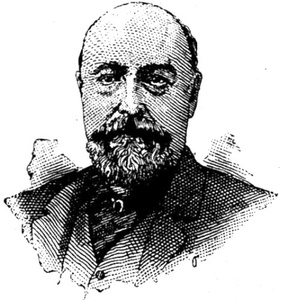 Plattsburgh Sentinel, October 3, 1890Plattsburgh Sentinel, October 3, 1890
Plattsburgh Sentinel, October 3, 1890Plattsburgh Sentinel, October 3, 1890
PAUL SMITH,
Paul Smith needs no introduction. Everybody knows who he is, and those who are personally acquainted with him will agree that this is a good portrait of him. We cannot give a better sketch than the following from the history of Clinton and Franklin counties, published in 1880. Large additions have been made to his house since this was written, and Smith is ten years older, but it is the same house and the same Paul Smith:
Three miles above Keese's Mill is a spot which has always been, even to the remotest limit of the oldest settler's memory, a favorite resort for hunters and fishermen. This place is on the west bank of Follensby's Pond [apparently referring to Lower Saint Regis Lake], the head waters of the St. Regis, while a few rods to the rear is Osgood's Pond, from which flows the east branch. Back to the utmost limit of historic time, Capt. Peter Sabattis, a noted St. Regis Indian, used to camp here, and later that mysterious old hunter, Moses Follensby, built and occupied a camp on this spot several seasons, summer and winter; and many old hunters and fishermen now living can attest, from personal experience, that there was no place like Follensby's Pond for killing deer and catching monstrous speckled trout. In 1853, Paul Smith commenced providing entertainment for sportsmen on Loon Lake, on the Port Kent and Hopkinton Turnpike, at the spot then known as the Lovering Place, and now kept as a sporting-house by Ferd. Chase. There Paul Smith stopped until 1858; then he moved down into the valley, a mile below, to the edge of the north branch of the Saranac, where he remained one year, at the place now known as Hunters' Home. But still he was not satisfied with his location for working out the mission of keeping a sporting house, which he began to feel was his destiny, and finally he came to Follensby's Pond in 1859, where he set himself down, perfectly satisfied with the spot. Since then he has kept adding year by year to the modest little structure he first moved into, and now, if the old hermit, Moses Follensby, or Capt. Peter Sabattis, should come back to their former haunts, they would be astonished to find, instead of the little log and bark shanty they left, a palatial hotel with accommodations for 300 guests, and in which 400 people are fed daily during the “season.” Everything inside is first-class and modern, and no better meals are served in city or country. The house stands on a high sand ridge, about fifteen feet above the level of the lake, in the midst of primitive pines; the nature of the soil is such that no pools of standing water are ever seen even after the hardest showers. Pure spring water is furnished in abundance, and nothing is omitted which can add to the health or comfort of guests. In the boat house, down at the edge of the water, are about 100 boats, and throughout the warm season crowds of guests arrive daily in stagecoaches, and stop permanently at the hotel, or make this their starting point for camping tours scores of miles away into the wilderness, reaching in all directions the vast system of waters of which this forms a part.
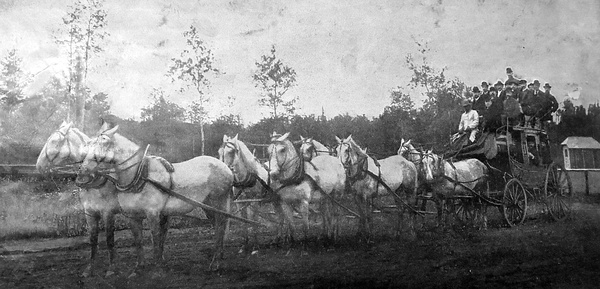 "New York Central Passenger Men
"New York Central Passenger Men
From a photograph by Woodward, Plattsburgh,"
Unidentified news clipping, c. 1900, from "Scrapbook No. 1," Saranac Lake Free Library"The time was when the saying was rife among tourists that there was “no Sunday in the Adirondacks, --that Sunday always got lost in coming up the long Black Brook Hill.” But this can no longer be said at St. Regis Lake, for a few rods away a little Protestant Episcopal church has been erected, whose musical bell reminds guests every Sunday morning during the height of the season of their religious duties.
Malone Palladium, December 18, 1890
Paul Smith's Hotel Company was incorporated on Thursday last—its stockholders being Apollos A. Smith and Lydia H. Smith, and their sons, Henry B. L. Phelps and Apollos A., Jr. .The capital stock is fixed at $100,000, and the articles of incorporation declare the objects for which the company is formed to be the keeping of hotels in the counties of Clinton, Essex and Franklin, and the purchase of real estate available for hotel purposes, and for use in the hotel business, and the preservation and improvement of such business; and the purchase and erection of hotels at such places as shall seem best in the prosecution of such business. The chief office of the company will be in Brighton, Franklin county, where the hotel which has given Mr. Smith fame and fortune is located.
Plattsburgh Daily Press, August 18, 1896
A fair for the benefit of the Adirondack cottage Sanitarium at Saranac Lake will be held in the ball-room of the hotel at Paul Smith's on Friday, August 21st.
New York Times, June 27, 1897 (A pdf of the full article is here)
ON MOUNTAINS AND LAKES
The Numerous Adirondack Resorts Now Ready to Receive the Summer Visitor.
Paul Smith's and Vicinity.
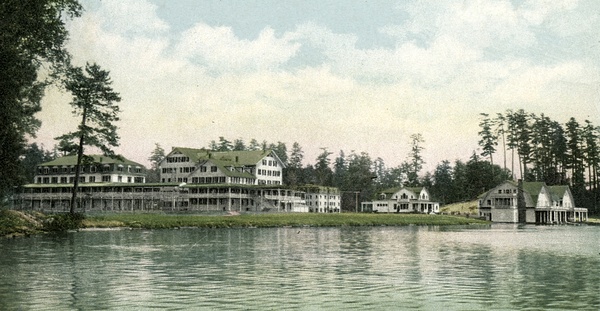 Paul Smiths, Adirondacks, N.Y. 1898 - 1931.
Paul Smiths, Adirondacks, N.Y. 1898 - 1931.
The Miriam and Ira D. Wallach Division of Art, Prints and Photographs:
Photography Collection, The New York Public Library.
The New York Public Library Digital Collections. "Paul Smith's" is one of the landmarks and most attractive features of the North Woods. The station is on the Adirondack Division of the New York Central, 130 miles north of Utica, and Paul Smith's hotel is about three miles and a half distant, situated on St. Regis Lake. This lake is about 2000 feet above tide water, and is surrounded by a dense growth of pine and balsam forest. For a long period of years "Paul Smith's (meaning practically the whole of the St. Regis Lake region) has held a first class reputation as a fishing and hunting ground. Lately it has become more and more of a fashionable resort. The hotel opened for the season on June 15, and there are already several guests there. The veteran Paul Smith is a picturesque character, and his abilities as a story teller form no insignificant part of the attractions of this resort. Paul has just returned from a visit to Cripple Creek and the Pacific coast, and his stock of thrilling narratives has been quaintly replenished.
Paul Smith's hotel and cottages will accommodate .about 350 guests. A large addition to the hotel was built two or three years ago. There is a general store in the hotel containing all necessaries for supplying camping parties, excepting tents and blankets. There are a Post Office and a telegraph office, also telephone connection with all of the principal resorts in the Adirondacks. The popular forms of diversion are boating, shooting, fishing, driving, bowling, lawn tennis, and billiards. Brook trout fishing is at its best in the months of May and June. Fly fishing is best in July, August, and September, up to the 15th. The law permits the killing of deer from Aug. 15 to Nov. 1. The hounding of deer is permitted between Sept. 1 and Oct. 5. The waters of the lower St. Regis are stocked yearly with brook and lake trout from the Adirondack State Hatchery...
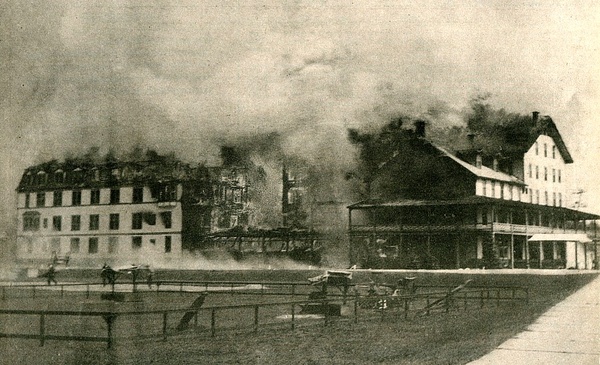 Paul Smith's Hotel fire, September 5, 1930. Adirondack Daily Enterprise, August 22, 1987
Paul Smith's Hotel fire, September 5, 1930. Adirondack Daily Enterprise, August 22, 1987
The Adirondack Enterprise, July 17, 1902
An item from the Saranac Lake column.
-- . . . Paul Smith's Sunday . . . a nurse is said to have . . . the burning of two . . . entrusted to her care--the . . . - old twin daughters of Mrs. Basil ___ . . . of Baltimore, Md. As the nurse [wa]s putting the young charges to bed, draperies of the couch caught fire . . . a lighted candle which she carried in her hand. Terrorized, she tried to extinguish the blaze and rescue the children, but did not succeed until they had been dangerously burned, one about the abdomen and limbs and the other about the head and face. Dr. Trudeau hopes to be able to save the children. Both were very beautiful and had attracted much attention from cottagers and hotel guests in that section. Since the above was put in type we learn that one of the children has died of her injuries.
Plattsburgh Press, August 30, 1904
A New "Paul Smith's."
A Magnificent Structure Planned for Season of 1906.
Plans are being prepared for a new Paul Smith's to be completed and opened for the tourists in June, 1906. The present structure will not, however, be disturbed during 1905, and the hotel will be opened throughout next season.
It is proposed to build the new Paul Smith's along the lines of the most modern hotel in the world. The structure will be 700 feet long, four stories in height and accommodate 700 people. The first two stories will be of stone and the remaining portion of wood. The new Casino will be further extended to include a ballroom and theatre.
Malone Farmer, September 10, 1930
FLAMES DESTROY PAUL SMITHS HOTEL, PIONEER HOSTELRY OF THE ADIRONDACK SECTION
Popular Resort Hotel Burns Despite Efforts of Fire Departments of Saranac, Placid and Tupper Lakes.— Loss Estimated at Quarter of a Million Dollars.
Fire Friday leveled Paul Smith's hotel, one of the oldest and most popular hostelries in the Adirondacks.
The lose was estimated at about $250,000. All of the 75 guests who had remained after the Labor Day Exodus, escaped uninjured.
The blaze is believed to have originated from a short circuit. When discovered by hotel employees shortly before noon, the fire was raging in a wing of the main building. Fanned by a strong southwest wind which blew off from St. Regis lake, on the shore of which the famous summer resort stood, the flames soon spread to all parts of the large frame structure.
Shortly after the fire started it was discovered that the hotel's fire-fighting apparatus was not functioning properly. Telephone calls to Saranac Lake, Lake placid and Tupper Lake brought immediate response from the fire departments of those villages. Tupper Lake's truck, manned by Fireman Robert Brown, made the longest trip to the scene, making the 27 miles in 32 minutes.
The trucks were driven to the shore and their pumps were started, drawing their water from the lake. Much difficulty was encountered in this procedure, the pumps often becoming clogged by debris that had settled on the bed forced to the surface by pump suction.
The attention of the firemen was turned to saving nearby structures. The store, post-office, other outbuildings and several cottages in the close vicinity were saved from the flames.
So intense was the heat and so rapid the spread of flames, that ever- green trees in the forest preserve which forms one of the beauty spots in that section, started burning. Soon after the trees ignited, however, the fire a this point, was extinguished after a short fight. A serious forest blaze was thus averted and thousands of acres of valuable forest land were saved.
Paul Smith's hotel, set high up in the mountains, had attracted tourists since its construction by Paul Smith, famous Adirondack guide, in 1856. It was nationally known as having housed a large number of distinguished guests. Among them were the late former President Grover Cleveland who, during his terms of office, spent each summer there. Former Governor Alfred E. Smith also has been a frequent visitor there.
During the summer of 1926 it was the summer White House. President Calvin Coolidge, spending the summer at Osgood Lake, three miles away, made the famous resort his stopping place on special occasions. The hotel was considered a luxurious sport center. It was opened in the summer of 1859.
Adirondack Record-Elizabethtown Post, July 12, 1934
Improving Paul’s Smith's Adirondack Club
Many reservations for the season are being received at Paul Smith's Adirondack Club, where work is being hurried to completion on extensive alterations on the Smith cottage, and on the rebuilt lake shore club house, the former Paul Smith's Hotel Casino.
Listings for Paul Smith's Hotel in the 1917 Mountain Home Telephone Company Directory:
Paul Smiths Casino
Paul Smiths Cooler
Paul Smiths Electric Launch House
Paul Smiths Express Office
Paul Smiths Freight House
Paul Smiths Garden
Paul Smiths General Office
Paul Smiths Hotel
Paul Smiths Kitchen
Paul Smiths Laundry
Paul Smiths Men's Building
Paul Smiths Mill
Paul Smiths Paint Shop
Paul Smiths Railroad, Motorman Brown
Paul Smiths R R Passenger Station
Paul Smiths, Stable and Garage
Paul Smiths Store
Paul Smiths Woman's Building
Paul Smiths Wood Working Shops
See also
- Paul Smith's Cottages
- St. Regis Golf Club
- Upper St. Regis Lake
- Spitfire Lake
- Seven Carries
- Paul Smith's Hotel Guides
Sources
• Donaldson, Alfred L., A History of the Adirondacks. New York: Century, 1921. ISBN 0-916346-26-8. (reprint)
• Jerome, Christine Adirondack Passage: Cruise of Canoe Sairy Gamp, HarperCollins, 1994. ISBN 0-93527294-1.
External links
- History of the Town of Brighton
- Adirondack Museum photographs of Paul Smiths Hotel
- ''New York Times'', August 30, 1903, "Season in the Adirondacks Shows No Signs of Waning; Outdoor Sports of All Kinds Followed by Fancy Dress Balls and Bowling and Pool Tournaments -- Fair at Paul Smith's Hotel a Big Success."
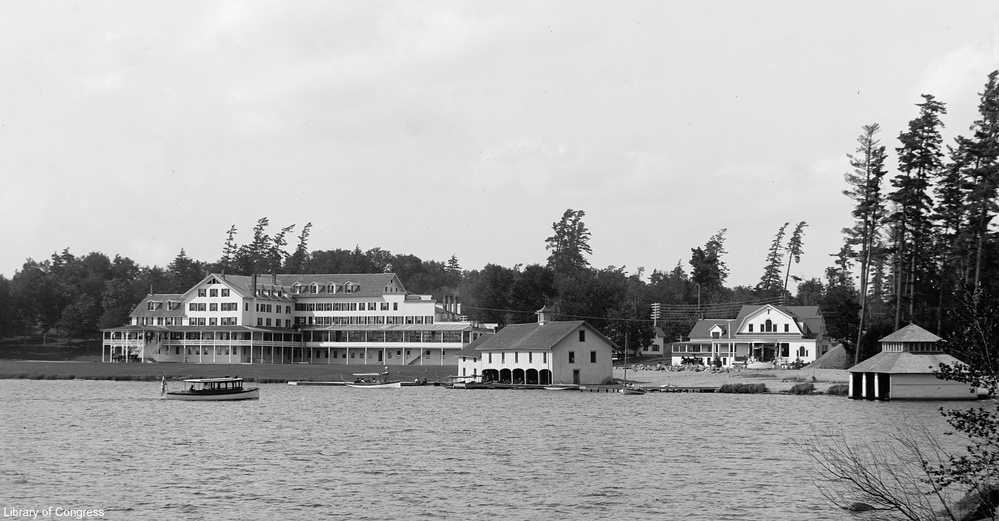 Paul Smith's from island, Lower St. Regis Lake, between 1900 and 1910
Paul Smith's from island, Lower St. Regis Lake, between 1900 and 1910
 Map of Paul Smith's Hotel Co., May 22, 1914. Courtesy of the Paul Smith's College Library Paul Smith's Archives Collection (high resolution copy available at link).
Map of Paul Smith's Hotel Co., May 22, 1914. Courtesy of the Paul Smith's College Library Paul Smith's Archives Collection (high resolution copy available at link).
 View of the back of the Paul Smiths Hotel, taken from the front side of the Smith Cottage, between 1903 and 1915. The three chimneys on the left side of the hotel serviced the expansive kitchen and bakery. Also pictured are the hotel casino (not for gambling, rather from a Latin root word for social club, or lodge), and the general store. Dated and labelled by Corey Laxson.
View of the back of the Paul Smiths Hotel, taken from the front side of the Smith Cottage, between 1903 and 1915. The three chimneys on the left side of the hotel serviced the expansive kitchen and bakery. Also pictured are the hotel casino (not for gambling, rather from a Latin root word for social club, or lodge), and the general store. Dated and labelled by Corey Laxson.
Courtesy of Paul Smith’s Archive, Paul Smiths College.



